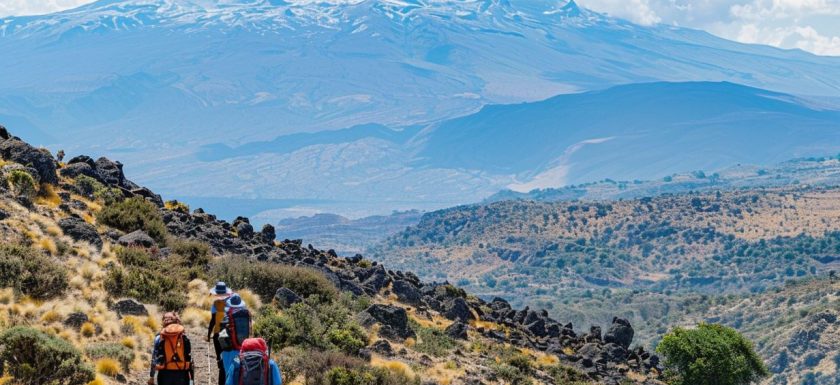
If you’re considering climbing Mount Kilimanjaro, one of the most popular routes to choose from is the Lemosho Route.
This route offers a unique and diverse trekking experience, with stunning scenery, abundant wildlife, and varying levels of difficulty.
In this article, we will explore the highlights of the Lemosho Route, the different sections you will encounter along the way, the best time to hike this route, and what essential items to pack for your journey.
So, lace up your hiking boots and get ready for an adventure of a lifetime!
Key Takeaways:
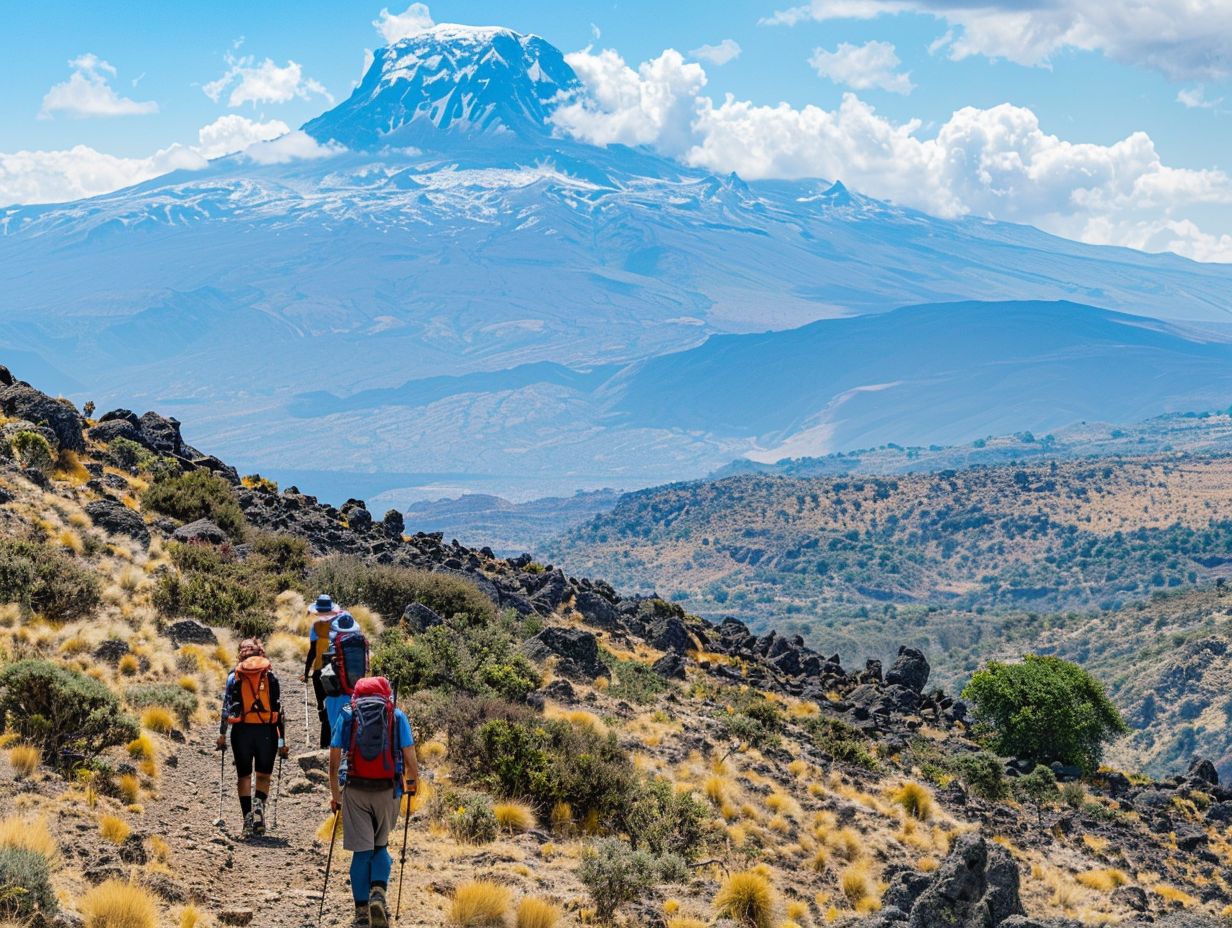
- The Lemosho Route offers a unique and less crowded trekking experience up Mount Kilimanjaro, making it a popular choice for adventurers.
- The route boasts magnificent scenery and diverse wildlife, offering an unforgettable journey through the African landscape.
- It is important to pack appropriate gear and plan for the best time to hike the Lemosho Route to ensure a successful and enjoyable trek to the summit of Kilimanjaro.
What is the Lemosho Route?
The Lemosho Route is a scenic and challenging trail that leads climbers to the summit of Kilimanjaro. Offering breathtaking views and diverse landscapes, it is renowned for its success rate and stunning natural beauty.
One of the key reasons why the Lemosho route has gained popularity among climbers is its gradual ascent profile, allowing for better acclimatization. This increases the chances of reaching the summit successfully while minimizing the risk of altitude sickness. The route also offers a more secluded experience compared to some of the busier paths, providing a sense of tranquility and solitude amidst the grandeur of Mount Kilimanjaro.
The uniqueness of the Lemosho Route lies in its varied terrain, from lush rainforests at lower altitudes to alpine desert zones higher up. This diversity in landscapes not only adds to the visual appeal but also enhances the overall trekking experience, offering a blend of challenges and rewards along the way.
Why Choose the Lemosho Route?
Climbers choose the Lemosho Route for its gradual ascent profile, which aids in altitude acclimatization, leading to a higher summit success rate. The route’s elevation gain and stunning scenery make it a favorite for those seeking both challenge and beauty on their Kilimanjaro climb.
One of the main reasons why climbers favor the Lemosho Route is its diverse landscapes, from lush rainforests to alpine deserts, providing a truly immersive experience.
This variety not only adds to the awe-inspiring journey but also aids in adjusting to different altitudes along the way. The gradual climb allows for better physical adaptation, reducing the chances of altitude sickness and increasing the likelihood of a successful summit attempt.
The strategic design of the Lemosho Route also offers ample time for climbers to acclimatize, with longer durations spent at higher camps. This extended acclimatization period is crucial for combating altitude-related issues, ensuring a safer and more comfortable climb.
What are the Highlights of the Lemosho Route?
The Lemosho Route is known for its spectacular scenery, including panoramic views of Kilimanjaro’s diverse landscapes. Wildlife sightings are common along the trail, adding a special touch to the climbing experience. The route’s moderate to challenging difficulty level offers a balanced adventure for climbers.
If you choose the Lemosho Route, you’ll embark on a journey that starts in the lush rainforest environment, gradually revealing stunning vistas as you ascend. The route boasts a variety of scenery, from moorlands to alpine deserts, providing a visual treat at every turn.
As you climb higher, the chance to spot native wildlife, such as playful colobus monkeys and elusive mountain antelopes, makes the trek even more memorable. Bird enthusiasts will be delighted by the array of species that call the region home.
In terms of difficulty, the Lemosho Route strikes a balance between challenge and accessibility. Climbers will face steep inclines, rocky terrain, and varying climates, offering a solid test of endurance and skills without being too technical or extreme.
Scenery and Views
The Lemosho Route offers breathtaking scenery, showcasing Kilimanjaro’s majestic glaciers and changing landscapes due to melting ice. The route’s beauty varies with the seasons, providing climbers with a dynamic and ever-evolving visual experience.
During the dry seasons, the sun’s golden rays glisten off the icy glaciers, creating a mesmerizing spectacle for trekkers. The crisp air allows for crystal-clear views of the surrounding landscapes, including the lush vegetation that thrives in the alpine zone. In contrast, the rainy seasons bring a new dimension to the route, with mist swirling around the peaks and adding an ethereal quality to the scenery.
Wildlife
The Lemosho Route offers unique wildlife encounters, especially near forest camps where climbers may spot various species of birds, monkeys, and other animals. The route’s proximity to natural habitats enhances the overall trekking experience.
One of the most fascinating aspects of the wildlife diversity along the Lemosho Route is the opportunity to witness the playful antics of vervet monkeys swinging from tree to tree near the forest camps. The rustling leaves often signal the presence of these agile creatures as they go about their daily routines.
The melodious chirping of vibrant bird species like the silvery-cheeked hornbill creates a symphony of sounds that echoes through the lush greenery surrounding the trail. Lucky trekkers might even catch a glimpse of the elusive turaco perched high up in the canopy.
As climbers traverse through the pristine wilderness, they may stumble upon the graceful impalas cautiously grazing in the meadows, adding a serene charm to the rugged landscape. The occasional sighting of majestic elephants or buffalo further accentuates the raw beauty of the forest camp areas along the route.
Difficulty Level
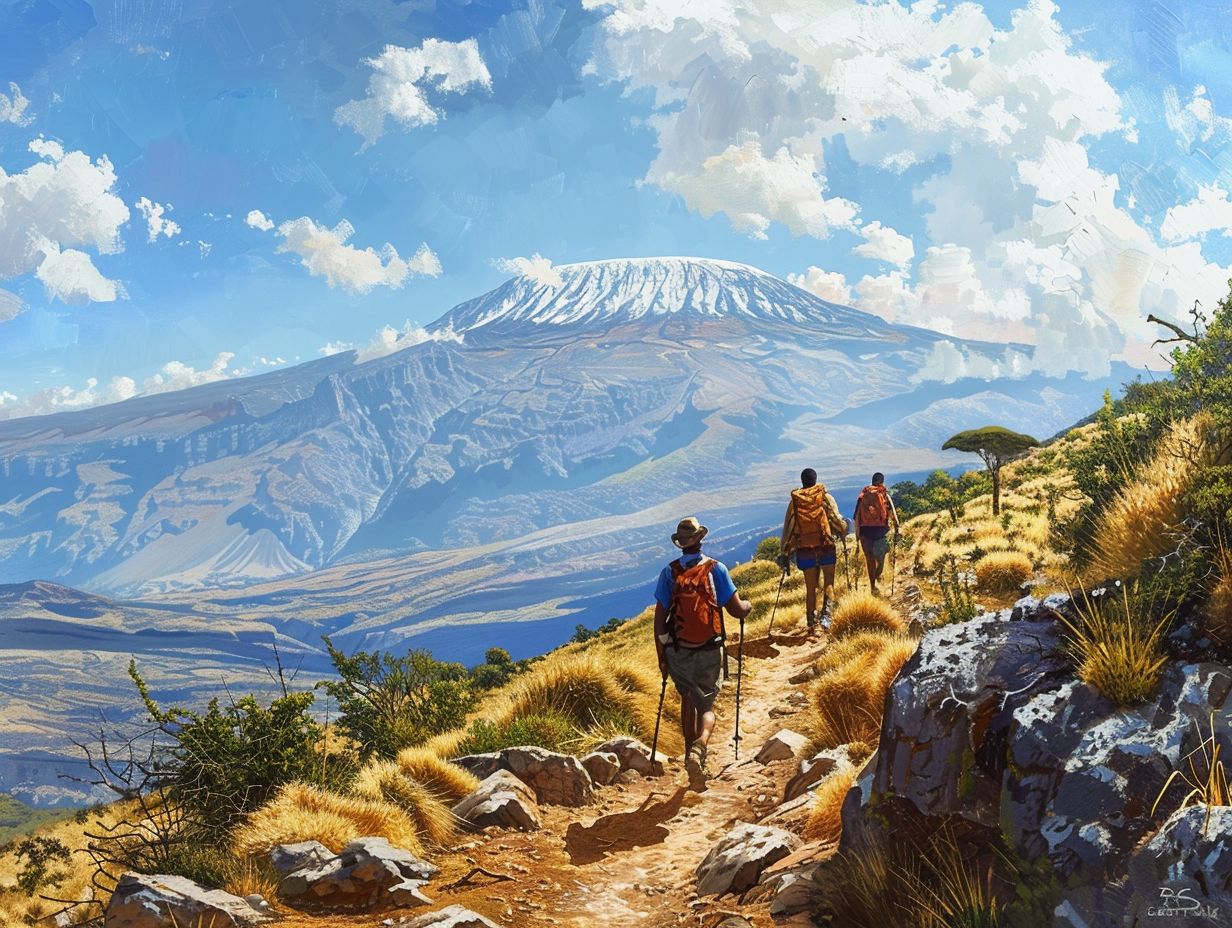
The Lemosho Route presents a moderate to challenging difficulty level, requiring climbers to adhere to the ‘climb high, sleep low’ principle for better acclimatization. Proper preparation and physical fitness are essential for conquering the route’s varying terrains and altitudes.
Altitude acclimatization is crucial on the Lemosho Route due to its significant elevation gains over a relatively short distance. The ‘climb high, sleep low’ strategy helps mitigate the effects of high altitudes, allowing climbers to adjust gradually.
This route demands endurance and strength as trekkers navigate through rainforests, heathlands, and alpine deserts, experiencing a drastic change in climate and terrain. Adequate preparation involves cardiovascular training, strength exercises, and mental readiness for the physical and mental challenges ahead.
How Long is the Lemosho Route?
The Lemosho Route typically spans over several days, covering a considerable distance as climbers ascend Kilimanjaro. The duration of the trek allows for gradual acclimatization and a rewarding climbing experience.
Throughout the journey, climbers immerse themselves in the stunning landscapes of lush rainforests, alpine meadows, and rocky terrain, experiencing the diverse ecosystems of the mountain.
With the longer duration compared to other routes, climbers have more time to adjust to the increasing altitude, reducing the risk of altitude sickness and increasing the chances of a successful summit attempt.
What are the Different Sections of the Lemosho Route?
The Lemosho Route consists of multiple sections, each offering unique challenges and scenic views. From lush forest camps to the final push towards the summit, each stage of the trail presents climbers with diverse landscapes and memorable experiences.
Starting the journey at the lush and dense rainforest camp, climbers are surrounded by a canopy of trees and a symphony of bird calls, creating a serene ambiance that marks the early stages of the trek.
Moving higher, the trail opens up to the heath and moorland zones where hikers witness the vast expanse of sweeping valleys and unique flora adapting to the higher altitude.
As climbers ascend further, they reach the alpine desert zone, a barren yet striking landscape that provides a surreal experience of being above the clouds.
The last leg of the journey culminates in the challenging but rewarding push towards the summit, where trekkers are greeted with breathtaking panoramic views and a sense of achievement that transcends words.
Day 1: Lemosho Glades to Big Tree Camp
On the first day of the Lemosho Route, climbers trek from the lush Lemosho Glades through enchanting forests to reach the tranquil Big Tree Camp. This initial stage sets the tone for the journey ahead, immersing climbers in Kilimanjaro’s natural beauty.
As the sunlight filters through the canopy of trees, the forested terrain provides a cool and refreshing start to the trek, offering moments of tranquility amidst the rustling leaves and bird songs. The air carries a unique earthy fragrance, enhancing the sensory experience of the hikers.
Upon arriving at Big Tree Camp, climbers are greeted by the sight of spacious tents nestled amidst the trees, offering a cozy retreat for the night. The camp setup reflects a harmonious blend of comfort and ruggedness, with campfires crackling in the evening light as the stars begin to emerge in the darkening sky.
The beginning of the trekking trail from the camp leads adventurers deeper into the heart of Kilimanjaro, with anticipation building for the challenges and wonders that lie ahead. Each step taken on the trail brings climbers closer to the iconic peak, weaving a narrative of determination and exploration through the rugged landscapes.
Day 2: Big Tree Camp to Shira Camp 1
Day 2 of the Lemosho Route involves the ascent from Big Tree Camp to the expansive Shira Plateau, where climbers are greeted with panoramic views and a sense of accomplishment.
The trail to Shira Camp 1 leads adventurers through a captivating journey of ascending terrain and captivating scenery. As you leave the lush surroundings of Big Tree Camp behind, the landscape gradually transforms into vast open spaces of the Shira Plateau. Here, the air feels crisper, the sky wider, and the sense of elevation becomes more palpable with each step.
The path winds through rocky outcrops and sparse vegetation, offering glimpses of endemic flora adapted to the high altitudes. The beauty of the surroundings is unparalleled, with the ruggedness of the mountain contrasting with the delicate alpine plants dotting the trail.
Day 3: Shira Camp 1 to Shira Camp 2
The trek from Shira Camp 1 to Shira Camp 2 on Day 3 of the Lemosho Route provides climbers with valuable acclimatization opportunities as they navigate the varying terrain and elevations. The campsites offer stunning views and a chance to rest before the next leg of the journey.
As climbers advance from Shira Camp 1 to Shira Camp 2, they experience a transition in the landscape, from the rocky moorland to the alpine desert.
This change in scenery not only captivates the senses but also plays a crucial role in acclimatizing the body to higher altitudes, reducing the risk of altitude sickness. The gradual ascent between these two campgrounds allows hikers to adapt slowly to the decreasing oxygen levels, ensuring a safer and more enjoyable trek.
Day 4: Shira Camp 2 to Barranco Camp
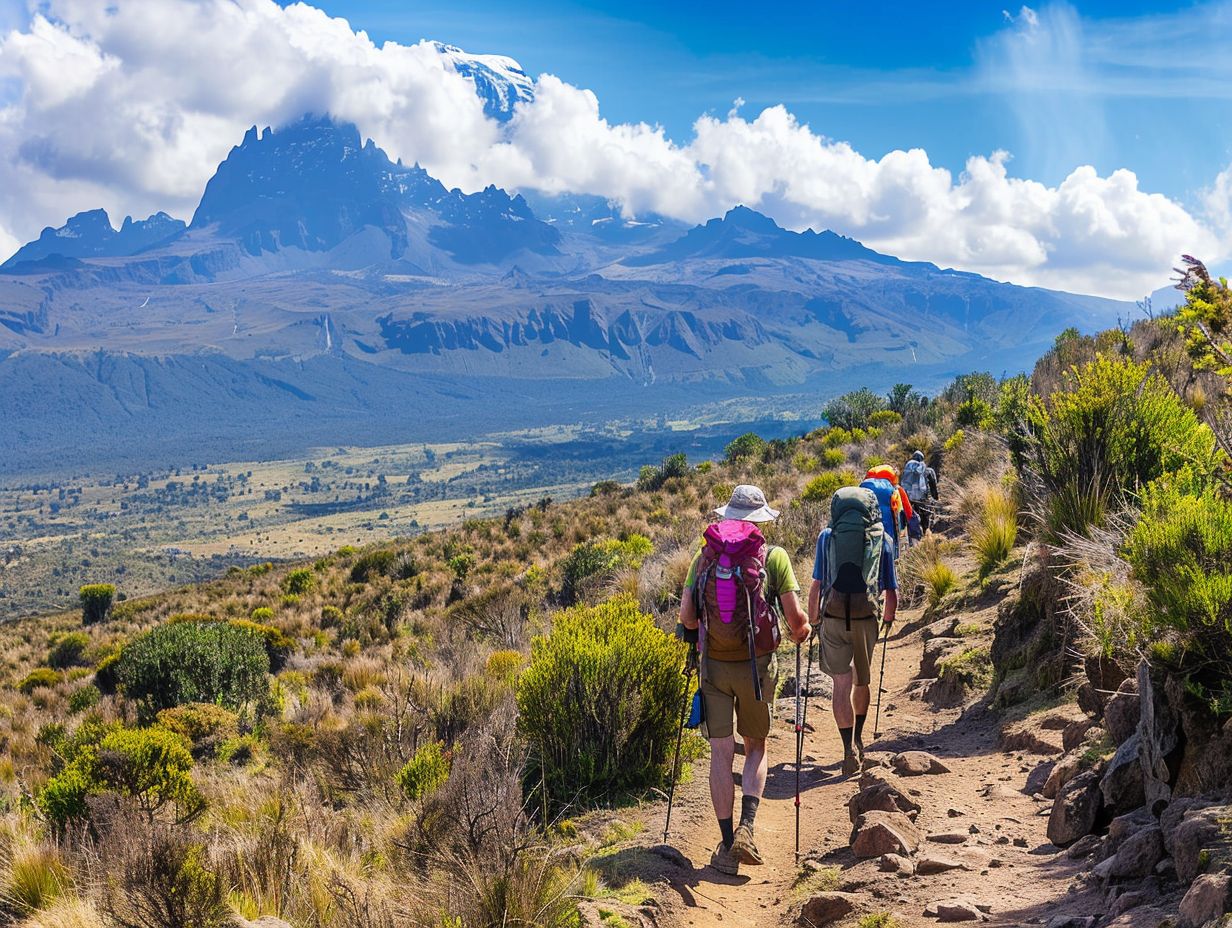
Day 4 of the Lemosho Route involves the trek from Shira Camp 2 to the iconic Barranco Camp, passing the challenging Barranco Wall. This section tests climbers’ skills and determination while rewarding them with stunning views and a sense of achievement.
The journey from Shira Camp 2 to Barranco Camp is a breathtaking experience that offers a mix of challenges and rewards. As trekkers leave behind the rocky terrain of Shira Camp 2, the trail gradually descends into the scenic Barranco Valley.
Barranco Wall, a massive volcanic rock face, looms ahead, providing a thrilling yet demanding ascent. Climbers navigate through steep rock slabs and scramble up the wall, using their hands and feet to conquer this natural obstacle.
Once atop the Barranco Wall, adventurers are greeted with magnificent panoramas of the surrounding landscapes. The juxtaposition of rugged cliffs and lush vegetation creates a striking backdrop against the clear skies. Descending from the wall, the trail weaves through diverse terrain, including alpine deserts and moorlands, offering a glimpse of Tanzania’s diverse ecosystems.
Day 5: Barranco Camp to Karanga Camp
The hike from Barranco Camp to Karanga Camp on Day 5 of the Lemosho Route marks a crucial stage before the summit day. Climbers traverse diverse terrain, prepare mentally for the summit push, and enjoy the stunning surroundings of Karanga Camp.
Leaving the rocky outcrop of Barranco behind, hikers start the day with a gradual ascent towards the next camp. The trail meanders through alpine deserts with sparse vegetation, offering glimpses of the looming peak of Kilimanjaro.
As climbers gain altitude, the air thins, and acclimatization becomes even more critical. Karanga Camp, nestled on a ridge, provides a strategic resting point to aid in this process. It’s a pivotal stop where trekkers refuel, hydrate, and acclimate for the challenges ahead on summit day.
Day 6: Karanga Camp to Barafu Camp
On Day 6, climbers ascend from Karanga Camp to the high-altitude Barafu Camp, the launching point for the summit bid. This challenging leg tests climbers’ endurance and determination, setting the stage for a high summit success rate on the final push.
Barafu Camp, situated at around 15,000 feet, offers a stark contrast to the lush surroundings of Karanga Camp, with rocky terrain and thinner air challenging climbers physically and mentally. The trail snakes through barren landscapes, offering breathtaking views of glaciers that glisten in the sunlight.
As climbers reach Barafu Camp, the focus shifts towards acclimatization and mental preparation, crucial elements for a successful summit attempt. The strategic location of Barafu Camp makes it a vital resting point, allowing climbers to recharge before the grueling final ascent to the summit.
Day 7: Barafu Camp to Uhuru Peak and Mweka Camp
The final day entails the challenging ascent from Barafu Camp to the majestic Uhuru Peak, the highest point of Kilimanjaro. Climbers savor the triumphant summit success before descending to Mweka Camp, concluding their epic journey with unforgettable memories.
On this crucial day, climbers wake up in the early hours of the morning to start their climb under the starlit sky, guided by the shimmering lights of fellow climbers’ headlamps. The air is thin, and each step becomes more arduous as they push themselves towards the summit success.
As the first morning light bathes the landscape in a soft glow, the snow-capped peak of Uhuru Peak beckons in the distance, energizing climbers with a renewed sense of determination.
Every step is a testament to their perseverance and dedication, every breath a reminder of the high altitude they are conquering. The sight of the iconic signpost at Uhuru Peak fills climbers with overwhelming joy and pride, symbolizing the culmination of their hard work and determination.
After capturing the breathtaking views from the summit and celebrating their success, climbers begin the descent to Mweka Camp, where they can finally rest and reflect on the incredible achievement.”
What is the Best Time to Hike the Lemosho Route?
The best time to hike the Lemosho Route is during the dry seasons, typically from June to October and from December to February. These periods offer stable weather conditions and clearer visibility, enhancing the overall climbing experience.
During these months, hikers can enjoy pleasant temperatures that are not too hot or too cold, making the trek more comfortable and enjoyable. The dry season also reduces the risk of rain, mudslides, and slippery trails, ensuring a safer journey.
The clear skies during the dry seasons provide stunning panoramic views of the surrounding landscapes, including the magnificent Mount Kilimanjaro. For those seeking an optimal hiking experience with minimal obstacles, choosing the dry season for embarking on the Lemosho Route is highly recommended.
What to Pack for the Lemosho Route?
Packing for the Lemosho Route requires careful consideration of essential gear such as high-quality clothing, sturdy footwear, and specialized equipment for high-altitude trekking. Proper preparation and attention to detail are crucial for a successful climb.
In terms of clothing, layers are key for adapting to the changing weather conditions along the route. Start with moisture-wicking base layers to keep you dry and comfortable, add insulating mid-layers, and top it off with a waterproof and windproof outer shell.
Footwear is another essential aspect to pay attention to. Invest in a pair of well-fitting, sturdy hiking boots with good ankle support to navigate the rugged terrain comfortably and reduce the risk of injuries.
Make sure to pack equipment such as trekking poles for stability, a quality sleeping bag rated for cold temperatures, a sufficiently warm sleeping pad for insulation from the ground, and a reliable headlamp for early morning starts.
Frequently Asked Questions
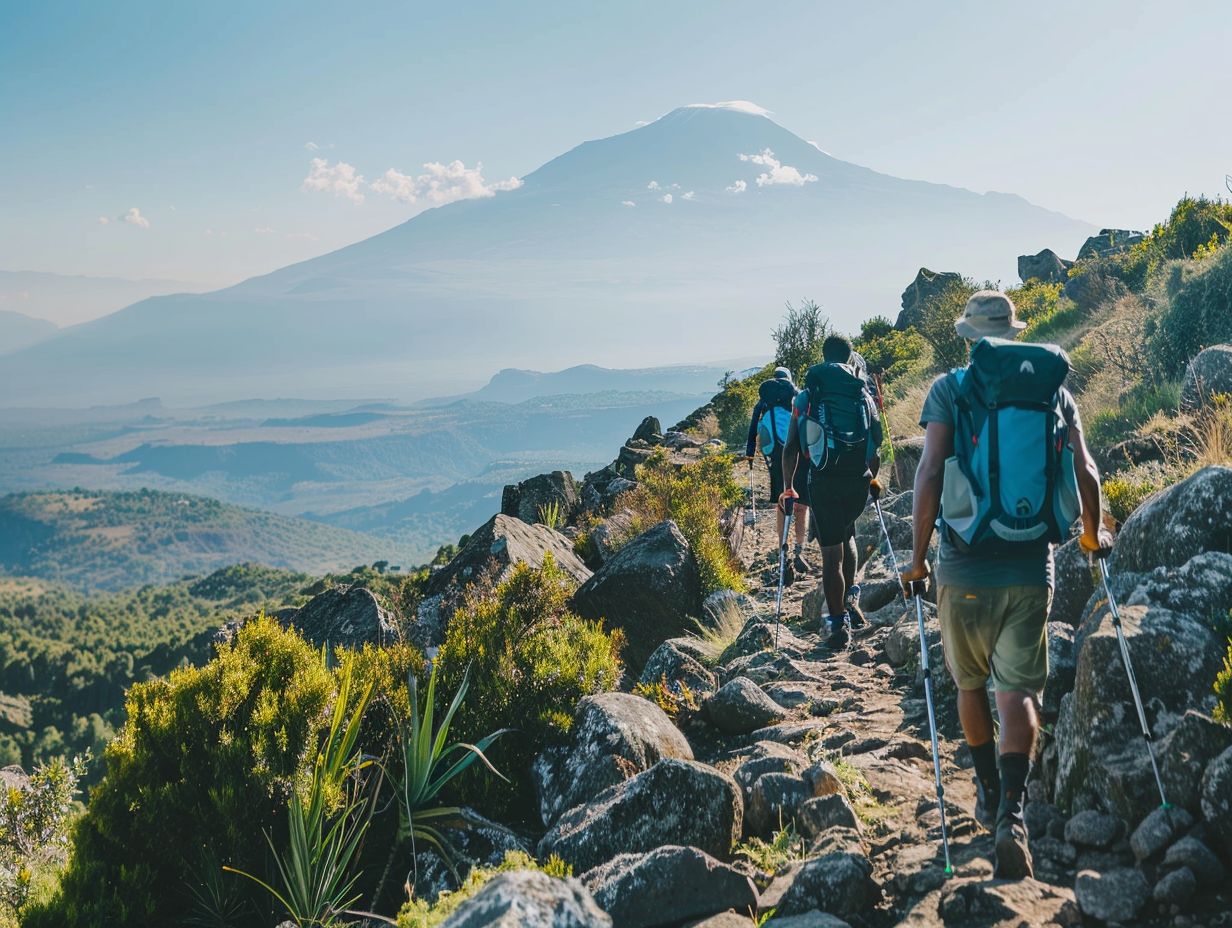
What is the Lemosho Route on Kilimanjaro?
The Lemosho Route is a popular and scenic trekking route on Mount Kilimanjaro in Tanzania. It is known for its beautiful landscapes and diverse wildlife, making it a popular choice among hikers.
How long does it take to hike the Lemosho Route on Kilimanjaro?
The Lemosho Route is a longer route compared to other options on Kilimanjaro, with an average of 8-9 days to complete. However, some companies offer extended versions of the route that can take up to 12 days.
Is the Lemosho Route on Kilimanjaro a difficult hike?
The Lemosho Route is considered a challenging hike due to its length and elevation gain. Hikers should have prior trekking experience and be physically fit before attempting this route.
What is the best time of year to hike the Lemosho Route on Kilimanjaro?
The best time to hike the Lemosho Route is during the dry season, which runs from June to October. This time of year offers clear skies, lower temperatures, and less chance of rain, making it ideal for trekking.
Are permits required for the Lemosho Route on Kilimanjaro?
Yes, all hikers on the Lemosho Route are required to have a permit to enter Kilimanjaro National Park. These permits can be obtained through a trekking company or directly from the park authorities.
What should I expect on the Lemosho Route on Kilimanjaro?
Hikers can expect a challenging but rewarding trek on the Lemosho Route. The route offers stunning views of the mountain, diverse landscapes, and a chance to spot wildlife such as elephants and buffalo. Campsites along the way provide basic amenities and meals.